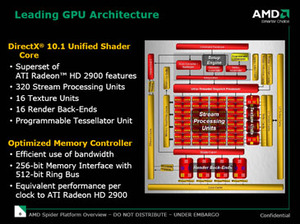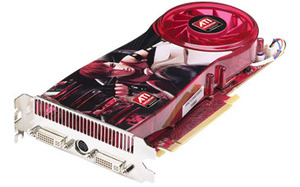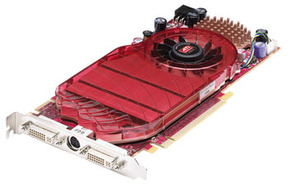This morning, AMD announced its ATI Radeon HD 3800 series of graphics cards, which are aimed right at the performance segment of the market.
The family comprises of two cards, the Radeon HD 3870 and Radeon HD 3850 which are both based on the same GPU – RV670. RV670 is fabbed on TSMC’s 55nm manufacturing process and features largely the same architecture as the Radeon HD 2900 XT, including 320 stream processors (still split into 64 five-way superscalar shader processors), 16 texture units, 16 ROPs, a ring bus memory architecture (albeit only 256-bit externally) and the tessellator unit. However, it adds support for DirectX 10.1, UVD and a number of other things.
One of the most impressive things we’ve seen about the architecture is its power saving technologies, which fall under the PowerPlay umbrella. If you’re familiar with ATI’s previous notebook GPUs, you will have heard of PowerPlay – it essentially enables much lower idle states to save power when the GPU is not doing an awful lot, or even if it’s under lighter loads.
The Radeon HD 3870 comes with a dual slot cooling solution and is clocked at 775MHz core. In its reference form, it features 512MB of GDDR4 memory that zips along at 2.25GHz (effective) and AMD has said that the maximum board power is around 105W – roughly the same as what the GeForce 8800 GT’s maximum board power. On the other hand, the Radeon HD 3850 comes with a single slot cooler and more conservative clock speeds – as a result, the maximum board power is lowered to just 95W. The 3850’s core is clocked at 670MHz, while the 256MB of GDDR3 memory is clocked at 1.66GHz (effective).
We’re currently working on our review of the cards, which should be online in the next couple of days. This delay is due to the short amount of time we’ve had with final hardware (the first cards arrived at the start of this week) and a number of problems we’ve encountered during our testing – we’re working those out as we go along, but things are looking promising for AMD thus far.
Both AMD and Sapphire have assured us that the products should hit around £140 (inc. VAT) and £110 (inc. VAT) upon release. However, given that retailers charged over the odds for the GeForce 8800 GT, we expect initial pricing to be higher – more in line with the pricing that was leaked just the other day. AMD last night told bit-tech that it believes that at these price points, it’s targeting around 50 million gamers compared to roughly one tenth of that it targeted with the higher price of the Radeon HD 2900 XT.
The same or higher performance at lower prices is definitely good for the consumer and we certainly welcome that, but there’s a lot of question marks in the graphics industry at the moment as Nvidia ironically decided to paper launch the GeForce 8800 GT 256MB card just yesterday in an attempt to soften the blow that the Radeon HD 3850 delivered to the GeForce 8600 GTS.
For now, you can discuss the new cards in the forums.
The family comprises of two cards, the Radeon HD 3870 and Radeon HD 3850 which are both based on the same GPU – RV670. RV670 is fabbed on TSMC’s 55nm manufacturing process and features largely the same architecture as the Radeon HD 2900 XT, including 320 stream processors (still split into 64 five-way superscalar shader processors), 16 texture units, 16 ROPs, a ring bus memory architecture (albeit only 256-bit externally) and the tessellator unit. However, it adds support for DirectX 10.1, UVD and a number of other things.
One of the most impressive things we’ve seen about the architecture is its power saving technologies, which fall under the PowerPlay umbrella. If you’re familiar with ATI’s previous notebook GPUs, you will have heard of PowerPlay – it essentially enables much lower idle states to save power when the GPU is not doing an awful lot, or even if it’s under lighter loads.
The Radeon HD 3870 comes with a dual slot cooling solution and is clocked at 775MHz core. In its reference form, it features 512MB of GDDR4 memory that zips along at 2.25GHz (effective) and AMD has said that the maximum board power is around 105W – roughly the same as what the GeForce 8800 GT’s maximum board power. On the other hand, the Radeon HD 3850 comes with a single slot cooler and more conservative clock speeds – as a result, the maximum board power is lowered to just 95W. The 3850’s core is clocked at 670MHz, while the 256MB of GDDR3 memory is clocked at 1.66GHz (effective).
We’re currently working on our review of the cards, which should be online in the next couple of days. This delay is due to the short amount of time we’ve had with final hardware (the first cards arrived at the start of this week) and a number of problems we’ve encountered during our testing – we’re working those out as we go along, but things are looking promising for AMD thus far.
Both AMD and Sapphire have assured us that the products should hit around £140 (inc. VAT) and £110 (inc. VAT) upon release. However, given that retailers charged over the odds for the GeForce 8800 GT, we expect initial pricing to be higher – more in line with the pricing that was leaked just the other day. AMD last night told bit-tech that it believes that at these price points, it’s targeting around 50 million gamers compared to roughly one tenth of that it targeted with the higher price of the Radeon HD 2900 XT.
The same or higher performance at lower prices is definitely good for the consumer and we certainly welcome that, but there’s a lot of question marks in the graphics industry at the moment as Nvidia ironically decided to paper launch the GeForce 8800 GT 256MB card just yesterday in an attempt to soften the blow that the Radeon HD 3850 delivered to the GeForce 8600 GTS.
For now, you can discuss the new cards in the forums.

MSI MPG Velox 100R Chassis Review
October 14 2021 | 15:04













Want to comment? Please log in.